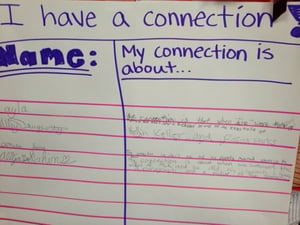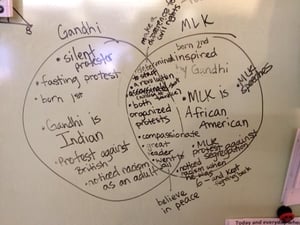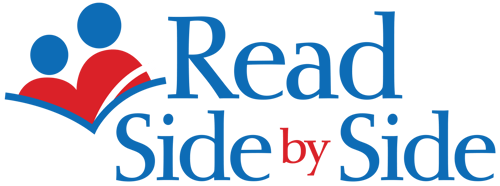 Well, we are finally halfway through Martin Luther King Jr.’s biography! It feels like we’ve been reading this short book forever…and yet the students are not bored or in need of extra entertainment to stay engaged. They have taken the big ideas and the details to heart, searching each week in library for connecting texts and noticing protests and boycotts on the news at home. There has been such an outpouring of connections, I have had to start a “waitlist” poster so I can pull connections when I am ready for them instead of giving up time we don’t have each day (I do think they could use up a whole subject area with excited sharing of connections – and I wish I could let them!)
Well, we are finally halfway through Martin Luther King Jr.’s biography! It feels like we’ve been reading this short book forever…and yet the students are not bored or in need of extra entertainment to stay engaged. They have taken the big ideas and the details to heart, searching each week in library for connecting texts and noticing protests and boycotts on the news at home. There has been such an outpouring of connections, I have had to start a “waitlist” poster so I can pull connections when I am ready for them instead of giving up time we don’t have each day (I do think they could use up a whole subject area with excited sharing of connections – and I wish I could let them!)
Writing
At this point, we have written our retell summary and first problem/solution/opinion piece along with several shorter responses to the Martin Luther King Jr. biography. For each writing task, I have given two levels of response options (sometimes it is not a choice and I give a few students a mandatory frame to help them be successful in writing with clarity, but I do post the frame for the rest of the class to use as needed. Students who use a frame just glue it in their reader’s notebooks.)
Between the retell summary and the problem/solution/opinion writing, I have seen great growth in independence. Some students continue to answer with incomplete sentences or with complete disregard to the sentence frame, but more students are choosing to elaborate on their own. Students seem invested in this subject matter (segregation and civil rights) and in Martin Luther King and his family, which has really made their writer’s voice stand out. I LOVE when a student asks, “Can I use my own words to say this?”
As I mentioned before, one of my teacher goals for this unit was to really take time for the ‘Stretch’ discussion questions at the end of many lessons. I think this has also helped with student connections and opportunities to organize their thinking and provide evidence from the text to back up their opinions. I decided to do some of these ‘stretches’ as writing prompts, working on compare and contrast.
 We started our compare and contrast work with the Gandhi article (Gandhi to MLK), creating a Venn Diagram and then completing a prompt to share how Gandhi and MLK were similar, how they were different, and student opinion if they were more similar or more different. We also wrote to prompts for the differences Martin noticed between the North and South. I was able to tell for those who struggled to organize compare and contrast how they would do on a similar prompt on our state testing. That small group met with me to discuss how to fix their prompts and also got a bonus lesson in answering questions.
We started our compare and contrast work with the Gandhi article (Gandhi to MLK), creating a Venn Diagram and then completing a prompt to share how Gandhi and MLK were similar, how they were different, and student opinion if they were more similar or more different. We also wrote to prompts for the differences Martin noticed between the North and South. I was able to tell for those who struggled to organize compare and contrast how they would do on a similar prompt on our state testing. That small group met with me to discuss how to fix their prompts and also got a bonus lesson in answering questions.
I have really loved using the CIA strategy of targets for each section of our writing (using the red stickers and white hole protectors to create targets.) The students feel very proud when they get all three and it lets them know exactly which part they need to keep working on, if they don’t get a target when they think they are done.
We will be using the CIA idea for a writing rubric, focused on the 6 traits and CCSS language during our book clubs for the end of quadrant writing. This rubric is organized from most crucial to least crucial writing skills, and will give both the students and I a clear place to start when revising their academic writing. I cannot wait to see how it works! It will also be a place to clearly note when students are still in need of copying my modeled writing and when they are ready for independence.
